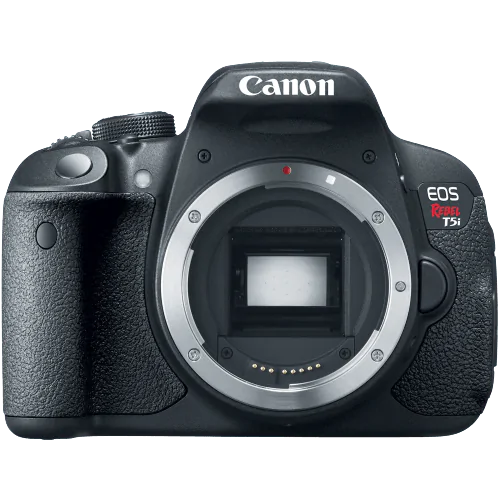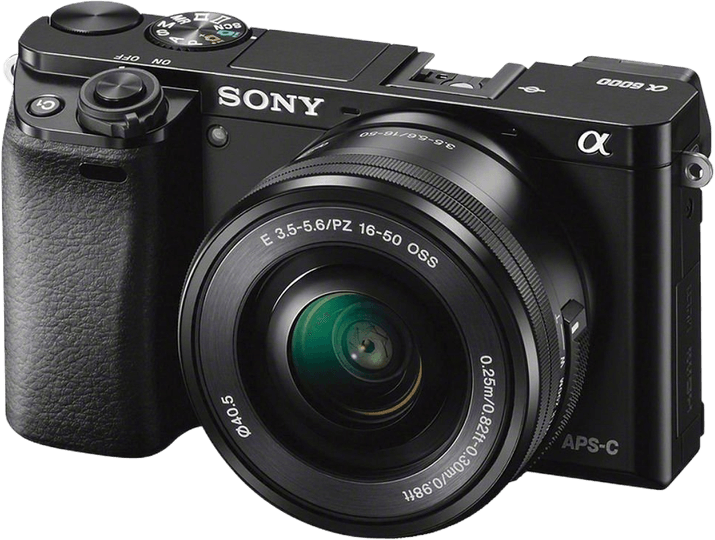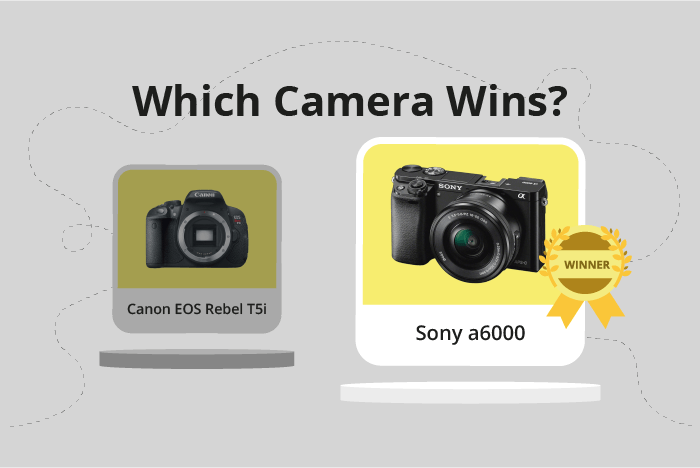Canon EOS Rebel T5i / 700D vs Sony a6000 Comparison
Canon EOS Rebel T5i / 700D

Sony a6000

The Sony a6000 outperforms the Canon EOS Rebel T5i / 700D by 13 points, scoring 57/100 compared to the Canon’s 44/100. Both cameras were released in 2013 and 2014, with similar launch prices of $750 and $799, respectively. They share common specifications, such as being DSLR and mirrorless camera types.
The Sony a6000 surpasses the Canon in terms of size and weight, measuring 120 x 67 x 45mm and weighing 344g, making it more compact and lighter than the Canon, which measures 133 x 100 x 79mm and weighs 580g. This advantage makes the Sony a6000 more portable and easier to handle.
On the other hand, the Canon EOS Rebel T5i / 700D is a DSLR camera, which some photographers prefer for its optical viewfinder and more extensive lens options. However, its larger size and weight may be a disadvantage for on-the-go photography.
Taking these factors into account, the Sony a6000 proves to be a more versatile and portable option, while the Canon EOS Rebel T5i / 700D may appeal to those who prefer DSLR cameras and their features.
Canon EOS Rebel T5i / 700D vs Sony a6000 Overview and Optics
The Sony a6000 takes the lead in optics, scoring 67 out of 100, while the Canon EOS Rebel T5i / 700D scores 40. Both cameras share common specifications such as APS-C sensor size, CMOS sensor type, and lack of image stabilization. Additionally, they both have unique lens mounts – the Canon with its EF-S mount and the Sony with its E mount.
The Sony a6000 outperforms the Canon T5i in several aspects. It has a higher megapixel count of 24.3 compared to the Canon’s 18, allowing for more detailed images. The shooting speed of the a6000 is 11 frames per second, more than double the T5i’s 5 frames per second, making it more suitable for capturing fast-moving subjects. The a6000 also has a superior DXOMARK sensor score of 82, as opposed to the T5i’s 61, indicating better overall image quality.
However, the Canon T5i does have some advantages. Its Digic 5 processor may not be as advanced as the Sony’s Bionz X, but it still delivers reliable performance. The T5i also benefits from a wide range of compatible lenses due to its EF-S lens mount, while the Sony E mount has fewer options available.
Taking these factors into account, the Sony a6000 emerges as the better option for those seeking superior optics and faster shooting speeds. However, the Canon T5i remains a viable choice for those who prioritize lens compatibility and are content with its performance capabilities.
Canon EOS Rebel T5i / 700D vs Sony a6000 Video Performance
The Sony a6000 outperforms the Canon EOS Rebel T5i / 700D in video capabilities, with a video score of 56/100 as opposed to the T5i’s 43/100. Both cameras share some common video specifications, including a maximum video resolution of Full HD and dimensions of 1920 x 1080. Neither camera has built-in time-lapse functionality.
The Sony a6000’s higher score is due to its superior maximum video frame rate of 60fps, which is double the T5i’s 30fps. This higher frame rate allows for smoother video playback and the ability to create slow-motion effects in post-production. As a result, the a6000 provides better video quality and versatility for users who prioritize video recording.
On the other hand, the Canon T5i does not offer any significant advantages in video capabilities compared to the Sony a6000. Its lower video score and maximum frame rate of 30fps make it less suitable for those who require high-quality video performance.
Taking these factors into consideration, the Sony a6000 emerges as the superior choice for video capabilities due to its higher video score and maximum frame rate. The Canon T5i, on the other hand, may not be the ideal choice for users who place a high priority on video performance.
Canon EOS Rebel T5i / 700D vs Sony a6000 Features and Benefits
The Canon EOS Rebel T5i / 700D outperforms the Sony a6000 in features, scoring 57 out of 100, compared to the Sony’s score of 41. Both cameras have a 3-inch screen, but the Canon T5i has a higher screen resolution of 1,040,000 dots, while the Sony a6000 has 921,600 dots. Additionally, the Canon T5i has a touchscreen, giving it an advantage over the Sony a6000, which lacks this feature.
Both cameras have a flip screen, making it convenient for capturing images from different angles. However, neither camera has GPS or Bluetooth capabilities. The Sony a6000 does have an advantage in connectivity, as it features Wi-Fi, while the Canon T5i does not.
The Canon T5i’s higher screen resolution and touchscreen give it an edge in usability and image preview quality. These features make it easier to navigate menus and review images, ultimately enhancing the user experience. On the other hand, the Sony a6000’s Wi-Fi capability allows for easy image transfer and remote control, which can be useful for photographers who need to quickly share their work or control their camera from a distance.
In comparing the features of the Canon EOS Rebel T5i / 700D and the Sony a6000, the Canon T5i has a clear advantage in screen resolution and touchscreen functionality. These features contribute to a better user experience, making the Canon T5i a more appealing choice for many photographers. However, the Sony a6000’s Wi-Fi capability should not be overlooked, as it offers valuable connectivity options for certain users.
Canon EOS Rebel T5i / 700D vs Sony a6000 Storage and Battery
The Canon EOS Rebel T5i / 700D outperforms the Sony a6000 in storage and battery with a score of 24/100, compared to the Sony’s 21/100. Both cameras have one memory card slot and accept SD, SDHC, and SDXC cards. However, the Sony a6000 also supports Memory Stick Pro Duo and Pro-HG Duo cards, providing additional storage options.
The Canon T5i has a longer battery life, allowing for 440 shots, while the Sony a6000 can only take 360 shots before needing a recharge. Both cameras use different battery types, with the Canon using the LP-E8 and the Sony using the NP-FW50. Neither camera offers USB charging capabilities.
Despite the Sony a6000’s lower score, its advantage lies in the additional memory card formats it supports. However, the Canon T5i’s longer battery life makes it the better choice in terms of storage and battery performance.
Alternatives to the Canon EOS Rebel T5i / 700D and Sony a6000
Are you still undecided about which camera is right for you? Have a look at these popular comparisons that feature the Canon EOS Rebel T5i / 700D or the Sony a6000:

